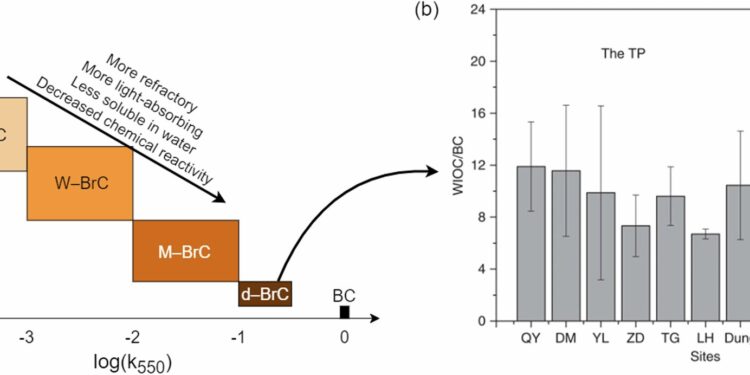Optical and physicochemical properties of d-BrC in the atmosphere and its abundance relative to BC in snow. Credit: npj Climate and Atmospheric Sciences (2024). DOI: 10.1038/s41612-024-00738-7
Wildfires leave behind powerful climate warmers, particles that enhance the absorption of sunlight and warm the atmosphere. Settled on snow like a wool poncho, these aerosols blacken and reduce the reflectivity of the surface of snowy areas.
But until now, it was unclear exactly how different types of smoke particles contribute to these effects. In a study recently published in npj Climate and Atmospheric SciencesResearchers at Washington University in St. Louis have modeled how dark brown carbon (d-BrC) — a light-absorbing, water-insoluble organic carbon — from wildfires plays a much larger role as a snow warmer than previously recorded. It’s 1.6 times more potent than what researchers thought was the main culprit, black carbon.
On the Tibetan Plateau and other mid-latitude regions, deposits of water-insoluble organic carbon on snow have been observed before. “But no one has really looked under the hood to study their snowmelt potential,” said Rajan Chakrabarty, a professor in WashU’s McKelvey School of Engineering.
Chakrabarty’s doctoral student Ganesh Chelluboyina, a member of the McDonnell International Scholars Academy, and postdoctoral researcher Taveen Kapoor have spent much of their time at WashU addressing this challenge.
The team likens d-BrC to an “evil cousin” of black carbon, and like black carbon, wildfires deposit it on snow caps like replacing a white T-shirt with a dark brown poncho. These particles can’t be washed off or bleached to the point where they lose their absorbency. And when snow loses its reflectivity and warms, it raises the temperature of the surrounding air, further accelerating the warming cycle.
Without accounting for d-BrC, the researchers likely underestimated snowmelt from wildfire smoke deposition, and this research will ensure more accurate climate models and measurements. As massive wildfires become more pervasive, policymakers will need to figure out how to mitigate this form of carbon to reduce abnormal snowmelt. While d-BrC absorbs slightly less light than black carbon, it makes up for it in quantity, being four times more abundant in wildfire plumes than BC.
The team plans to further document the real-world effects of d-BrC during the experimental phase of the research. How do you conduct snow aerosol experiments without going into the field? In this case, they procure a four-foot-tall snow globe for the lab.
“We will drop atomized water droplets into the top of the chamber, creating snow, and then deposit aerosols on top,” Chelluboyina said.
More information:
Ganesh S. Chelluboyina et al., Dark brown carbon from wildfires: a potent radiative forcing agent of snow?, npj Climate and Atmospheric Sciences (2024). DOI: 10.1038/s41612-024-00738-7
Provided by Washington University in St. Louis
Quote: Scientists Discover Hidden Source of Snow Melt: Dark Brown Carbon (2024, September 4) Retrieved September 4, 2024 from
This document is subject to copyright. Apart from any fair dealing for the purpose of private study or research, no part may be reproduced without written permission. The content is provided for informational purposes only.



